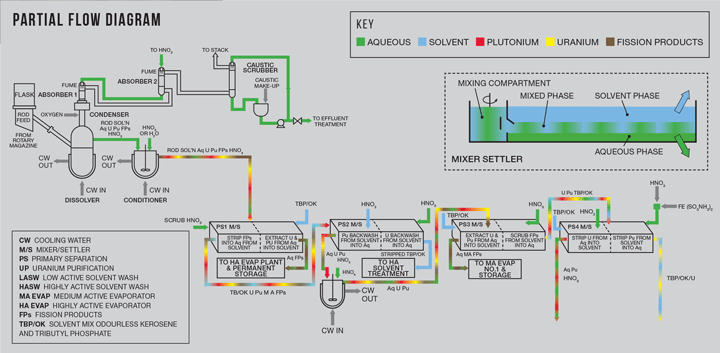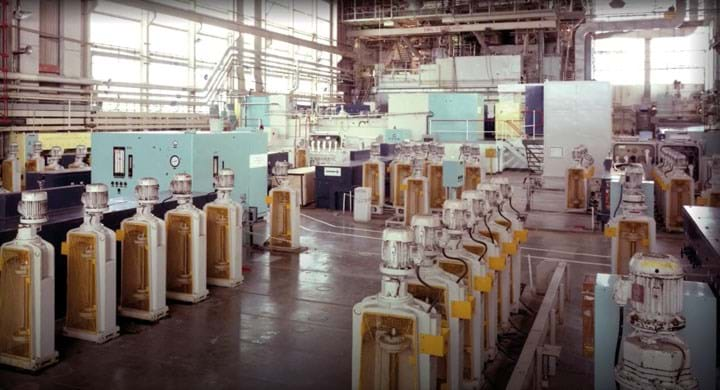Magnox reprocessing: The end of an era
Preparing for cleanout and decommissioning
AFTER nearly 60 years of operations, Sellafield’s Magnox plant will stop reprocessing in mid-July, transitioning into a decades-long phase of cleanout and decommissioning before its eventual demolition.
Since it started operating in 1964, the plant has received and reprocessed more than 55,000 t of spent nuclear fuel from the UK’s Magnox nuclear power stations. “There were 11 Magnox reactor sites across the UK. The last one in operation was Wylfa, and it ceased generation in 2015,” said Jennifer Horstwood, Lead System Engineer for Magnox reprocessing.
Horstwood and Scott Kaighan spoke to The Chemical Engineer about the end of reprocessing and what comes next for the plant and the engineers responsible for operations. Kaighan leads post-operational cleanout (POCO) for Magnox reprocessing.
Magnox reprocessing
Nuclear reprocessing is used to break spent fuel down to its component parts – uranium, plutonium, and fission products formed as a result of energy generation. Magnox has been reprocessing spent fuel since it received its first active feed on 11 June 1964, and it will come to an end on 18 July.
Through the decades there have been changes to the process. Horstwood explained how reprocessing currently occurs at Magnox. She said that before it begins, fuel is decanned from its outer casing. The outer casing is encapsulated for interim storage pending final disposal in the geological disposal facility, while the spent fuel rods are transferred to the reprocessing plant. There, the rods are fed into a dissolver, which is supplied with acid and heated to enable dissolution. In a conditioner, the acidity of the dissolved feed is adjusted to ensure it is in the right condition before it enters the main solvent extraction process. The product then goes through “a number of mixer settlers”.
Mixer settlers consist of a mixing compartment and settling section. The former mixes the aqueous and solvent phases and the settler section enables the two phases to settle out. Mixer settlers are made up of a number of stages and are all different sizes, varying from 3–4 stages to as many as 18. The multiple stages increase the reaction time and efficiency of the purification/separation.
Removal of fission products starts in the first mixer settler. This is achieved by adjusting the conditions to extract the uranium and plutonium into the solvent phase with the fission products remaining in the aqueous phase. Fission product removal is completed in the Primary Separation stage 2 (PS2) and PS3 (depicted in the figure, below), leaving in the aqueous phase. They are then sent to downstream facilities for evaporation and storage.
In PS4, uranium and plutonium are separated. Horstwood said ferrous sulfamate is used to reduce valency of plutonium to enable separation of the elements into different phases. The temperature and acidity are controlled to impact whether it’s favourable for the elements to be in the solvent phase (plutonium) or the aqueous phase (uranium). Nitric acid acts as the aqueous phase and the solvent phase is a mixture of odourless kerosene and tributyl phosphate. Horstwood added that the plutonium and uranium purification processes are again “made up of a number of mixer settlers for further purification and removal of residual fission products, and to ensure that the conditions are correct for conversion to powder”.
The separated uranium and plutonium streams are treated in downstream plants, with the uranium going through evaporation and a thermal denitration reactor to give uranium trioxide (UO3) powder. Plutonium processing results in plutonium dioxide (PuO2) powder. The powders are stored separately with the PuO2 staying at the Sellafield site, while UO3 is stored at the Capenhurst nuclear site in Cheshire, UK.

The end and what comes next
Having reprocessed well over 99% of total Magnox fuel, and with just 250 t of spent fuel remaining unprocessed, Magnox operations are able to come to an end. The remaining spent fuel has been assessed by Sellafield’s strategy and technical team which has determined it can be safely stored using existing facilities at Sellafield whilst the future lifecycle is developed.
Kaighan discussed what the next steps are for the plant once reprocessing ends. Firstly, the site will go into a period of site outage due to end in about September, which will be followed by end of operations rundown to between April and July 2023. He explained that rundown effectively involves removing as much of the inventory as possible – including uranium, plutonium, COMAH related chemicals, and solvents – and getting the facility into a position to start POCO, due to start in summer 2023.
He said: “There will then be a series of washouts aimed at reducing the overall activity associated with the vessels within the facilities, and that is effectively due to last between three and four years. The overall aim of that is to try and increase the amount of access we have to decommission the plant.”
Washout will involve running the process without fuel feed, followed by system flush throughs, including of lines not usually used as part of the process such as overflow/drain lines. Targeted washes will be either by acid wash, boil wash, or high-pressure water jetting depending on the material that vessels/pipework have been in contact with and the configuration of vessels/reagent supplies.
POCO will also involve trying to reduce the categorisation of waste. According to Kaighan, reducing waste activity levels from high-level to intermediate level, for example, enables “massive” cost savings.
Following POCO, there will be a period of about five years surveillance and maintenance “where effectively there isn’t much [activity] going on other than monitoring the plant”, said Kaighan. This period has the benefit that some radioactive species will decay over time, reducing overall activity before decommissioning starts. Magnox decommissioning is due to start in 2030 and expected to last until 2096. This is according to a schedule that will see all of Sellafield remediated over the next 100 years.
Kaighan highlighted that the “current plan is that the people operating the facility now and the engineers associated with it will transition with the facility into post-operational cleanout. The idea being that the people who have developed the knowledge and experience over time will be the same people that are taking the facility into its next life cycle.”
These workers can later use that experience to support other facilities at Sellafield site. Magnox currently has more than 250 people working in reprocessing.

A long life
Acknowledging the Magnox facility’s original design intent of about 20 years, Horstwood said that as it stops operations Magnox is approaching three times its intended lifetime.
Discussing what has allowed such a long life to be achieved, she mentioned “major refurbishment projects”. For example, in the 1970s the plant’s first plutonium evaporator was replaced informed by learnings from corrosion rates. This resulted in a change of vessel construction material from titanium to zirconium.
Kaighan added that duty standby ability has been beneficial. The facility has duty standby capability which allowed the plant to run while refurbishments were carried out in parallel on non-operating vessels. This capacity was built-in because of concerns about potential issues with the plant’s longevity.
“Ultimately, this helped us in the long run,” Kaighan concluded.
Recent Editions
Catch up on the latest news, views and jobs from The Chemical Engineer. Below are the four latest issues. View a wider selection of the archive from within the Magazine section of this site.




